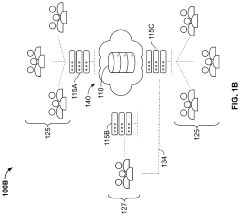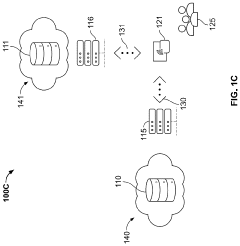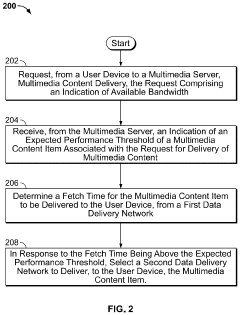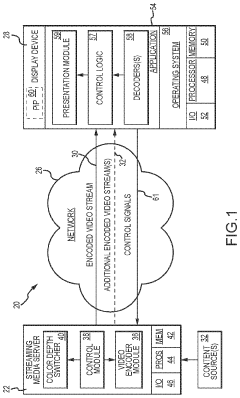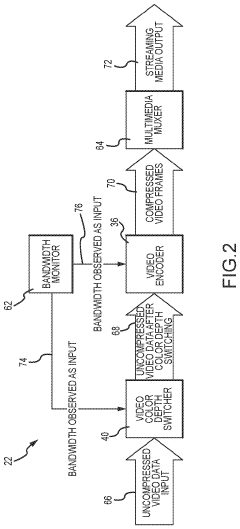Dolby Vision’s Adaptive Streaming: Impact and Efficiency
JUL 30, 20259 MIN READ
Generate Your Research Report Instantly with AI Agent
Patsnap Eureka helps you evaluate technical feasibility & market potential.
Dolby Vision Evolution
Dolby Vision has undergone significant evolution since its inception, transforming the landscape of high dynamic range (HDR) video technology. Initially introduced in 2014, Dolby Vision aimed to enhance the viewing experience by offering superior contrast, brightness, and color accuracy compared to standard dynamic range (SDR) content.
The early iterations of Dolby Vision focused primarily on static metadata, which provided a single set of instructions for the entire content. This approach, while groundbreaking, had limitations in adapting to varying scene characteristics throughout a video. Recognizing this constraint, Dolby engineers embarked on developing dynamic metadata capabilities, a crucial step in the technology's evolution.
Dynamic metadata allowed for frame-by-frame or scene-by-scene optimization of HDR content, enabling more precise control over brightness, contrast, and color. This advancement significantly improved the visual quality and consistency across different displays and viewing environments. As a result, Dolby Vision gained rapid adoption among content creators and device manufacturers.
The next phase in Dolby Vision's evolution addressed the challenge of efficient content delivery. With the rise of streaming services and varying network conditions, Dolby introduced adaptive streaming capabilities. This innovation allowed for real-time adjustment of video quality based on available bandwidth, ensuring a seamless viewing experience without compromising on the core benefits of HDR.
Dolby Vision IQ marked another milestone in the technology's progression. This feature incorporated ambient light sensors in compatible displays to automatically adjust picture settings based on the viewing environment. By considering factors such as room lighting, Dolby Vision IQ further enhanced the viewing experience, maintaining optimal image quality across various conditions.
Recent developments in Dolby Vision have focused on expanding its applicability beyond traditional film and television content. The technology has been adapted for gaming, offering enhanced visual experiences in interactive media. This expansion has required further refinements in low-latency processing and real-time rendering capabilities.
As the technology continues to evolve, Dolby Vision is increasingly integrating artificial intelligence and machine learning algorithms. These advancements aim to improve content analysis, optimize encoding processes, and enhance the adaptive streaming capabilities. By leveraging AI, Dolby Vision seeks to provide even more nuanced and efficient HDR experiences across a wider range of devices and content types.
The early iterations of Dolby Vision focused primarily on static metadata, which provided a single set of instructions for the entire content. This approach, while groundbreaking, had limitations in adapting to varying scene characteristics throughout a video. Recognizing this constraint, Dolby engineers embarked on developing dynamic metadata capabilities, a crucial step in the technology's evolution.
Dynamic metadata allowed for frame-by-frame or scene-by-scene optimization of HDR content, enabling more precise control over brightness, contrast, and color. This advancement significantly improved the visual quality and consistency across different displays and viewing environments. As a result, Dolby Vision gained rapid adoption among content creators and device manufacturers.
The next phase in Dolby Vision's evolution addressed the challenge of efficient content delivery. With the rise of streaming services and varying network conditions, Dolby introduced adaptive streaming capabilities. This innovation allowed for real-time adjustment of video quality based on available bandwidth, ensuring a seamless viewing experience without compromising on the core benefits of HDR.
Dolby Vision IQ marked another milestone in the technology's progression. This feature incorporated ambient light sensors in compatible displays to automatically adjust picture settings based on the viewing environment. By considering factors such as room lighting, Dolby Vision IQ further enhanced the viewing experience, maintaining optimal image quality across various conditions.
Recent developments in Dolby Vision have focused on expanding its applicability beyond traditional film and television content. The technology has been adapted for gaming, offering enhanced visual experiences in interactive media. This expansion has required further refinements in low-latency processing and real-time rendering capabilities.
As the technology continues to evolve, Dolby Vision is increasingly integrating artificial intelligence and machine learning algorithms. These advancements aim to improve content analysis, optimize encoding processes, and enhance the adaptive streaming capabilities. By leveraging AI, Dolby Vision seeks to provide even more nuanced and efficient HDR experiences across a wider range of devices and content types.
Adaptive Streaming Demand
The demand for adaptive streaming technology has grown exponentially in recent years, driven by the increasing consumption of video content across various devices and network conditions. Dolby Vision's Adaptive Streaming technology addresses this demand by offering a solution that dynamically adjusts video quality based on available bandwidth and device capabilities.
The market for adaptive streaming is primarily fueled by the rapid growth of over-the-top (OTT) platforms and video-on-demand (VOD) services. As more consumers shift away from traditional cable and satellite TV, the need for seamless streaming experiences becomes paramount. Dolby Vision's technology caters to this demand by ensuring high-quality video delivery even in challenging network environments.
Another significant factor driving the demand for adaptive streaming is the proliferation of mobile devices. With smartphones and tablets becoming primary screens for video consumption, users expect consistent quality regardless of their location or network connectivity. Dolby Vision's Adaptive Streaming addresses this need by optimizing content delivery for various screen sizes and resolutions.
The increasing adoption of 4K and HDR content has also contributed to the demand for more efficient streaming technologies. As these high-quality formats require substantial bandwidth, adaptive streaming solutions like Dolby Vision's become crucial in delivering premium content without compromising on quality or user experience.
Furthermore, the global pandemic has accelerated the shift towards remote work and online entertainment, leading to a surge in streaming traffic. This unprecedented increase in demand has highlighted the importance of adaptive streaming technologies in managing network congestion and ensuring uninterrupted video delivery.
In the enterprise sector, the rise of video conferencing and remote collaboration tools has created a new market for adaptive streaming solutions. Dolby Vision's technology can potentially be applied to these use cases, offering improved video quality and bandwidth efficiency for business communications.
The automotive industry is emerging as another potential growth area for adaptive streaming. As vehicles become more connected and autonomous, in-car entertainment systems are evolving to offer streaming capabilities. Dolby Vision's Adaptive Streaming could play a significant role in delivering high-quality content to moving vehicles with varying network conditions.
Looking ahead, the demand for adaptive streaming is expected to continue growing as 5G networks roll out globally. While 5G promises higher bandwidth and lower latency, adaptive streaming will remain crucial in optimizing content delivery across diverse network conditions and ensuring a consistent user experience.
The market for adaptive streaming is primarily fueled by the rapid growth of over-the-top (OTT) platforms and video-on-demand (VOD) services. As more consumers shift away from traditional cable and satellite TV, the need for seamless streaming experiences becomes paramount. Dolby Vision's technology caters to this demand by ensuring high-quality video delivery even in challenging network environments.
Another significant factor driving the demand for adaptive streaming is the proliferation of mobile devices. With smartphones and tablets becoming primary screens for video consumption, users expect consistent quality regardless of their location or network connectivity. Dolby Vision's Adaptive Streaming addresses this need by optimizing content delivery for various screen sizes and resolutions.
The increasing adoption of 4K and HDR content has also contributed to the demand for more efficient streaming technologies. As these high-quality formats require substantial bandwidth, adaptive streaming solutions like Dolby Vision's become crucial in delivering premium content without compromising on quality or user experience.
Furthermore, the global pandemic has accelerated the shift towards remote work and online entertainment, leading to a surge in streaming traffic. This unprecedented increase in demand has highlighted the importance of adaptive streaming technologies in managing network congestion and ensuring uninterrupted video delivery.
In the enterprise sector, the rise of video conferencing and remote collaboration tools has created a new market for adaptive streaming solutions. Dolby Vision's technology can potentially be applied to these use cases, offering improved video quality and bandwidth efficiency for business communications.
The automotive industry is emerging as another potential growth area for adaptive streaming. As vehicles become more connected and autonomous, in-car entertainment systems are evolving to offer streaming capabilities. Dolby Vision's Adaptive Streaming could play a significant role in delivering high-quality content to moving vehicles with varying network conditions.
Looking ahead, the demand for adaptive streaming is expected to continue growing as 5G networks roll out globally. While 5G promises higher bandwidth and lower latency, adaptive streaming will remain crucial in optimizing content delivery across diverse network conditions and ensuring a consistent user experience.
Technical Challenges
Dolby Vision's Adaptive Streaming technology faces several significant technical challenges in its implementation and widespread adoption. One of the primary hurdles is the complexity of real-time encoding and decoding of high dynamic range (HDR) content. This process requires substantial computational power, which can strain both server-side resources and end-user devices, particularly in mobile environments where processing capabilities may be limited.
Another challenge lies in the bandwidth requirements for streaming Dolby Vision content. While adaptive streaming techniques aim to optimize data transmission based on network conditions, the inherently larger file sizes of HDR content can still pose difficulties in maintaining consistent quality, especially in areas with unreliable or low-bandwidth internet connections.
Interoperability across different devices and platforms presents a significant obstacle. Ensuring that Dolby Vision content is correctly displayed on a wide range of screens, from high-end televisions to smartphones, requires extensive compatibility testing and potential firmware updates for existing devices. This fragmentation in the device ecosystem can slow down the technology's adoption rate.
Content creation for Dolby Vision also faces challenges. The production of HDR content requires specialized equipment and expertise, which can increase production costs and time. Additionally, there's a need for standardized workflows that can seamlessly integrate Dolby Vision into existing content creation pipelines without disrupting established processes.
The dynamic metadata management in Dolby Vision's Adaptive Streaming is another area of technical complexity. Accurately transmitting and applying scene-by-scene or frame-by-frame HDR metadata in real-time streaming scenarios demands precise synchronization and processing, which can be challenging to maintain consistently across various network conditions and playback devices.
Lastly, the challenge of backward compatibility with standard dynamic range (SDR) displays and content delivery systems cannot be overlooked. Ensuring that Dolby Vision content degrades gracefully on non-HDR displays while still providing an improved viewing experience compared to traditional SDR content is a delicate balance to achieve technically.
Addressing these technical challenges requires ongoing research and development efforts, collaboration between hardware manufacturers, content creators, and streaming platforms, as well as continuous refinement of encoding algorithms and streaming protocols to enhance efficiency and compatibility across the diverse landscape of consumer devices and network infrastructures.
Another challenge lies in the bandwidth requirements for streaming Dolby Vision content. While adaptive streaming techniques aim to optimize data transmission based on network conditions, the inherently larger file sizes of HDR content can still pose difficulties in maintaining consistent quality, especially in areas with unreliable or low-bandwidth internet connections.
Interoperability across different devices and platforms presents a significant obstacle. Ensuring that Dolby Vision content is correctly displayed on a wide range of screens, from high-end televisions to smartphones, requires extensive compatibility testing and potential firmware updates for existing devices. This fragmentation in the device ecosystem can slow down the technology's adoption rate.
Content creation for Dolby Vision also faces challenges. The production of HDR content requires specialized equipment and expertise, which can increase production costs and time. Additionally, there's a need for standardized workflows that can seamlessly integrate Dolby Vision into existing content creation pipelines without disrupting established processes.
The dynamic metadata management in Dolby Vision's Adaptive Streaming is another area of technical complexity. Accurately transmitting and applying scene-by-scene or frame-by-frame HDR metadata in real-time streaming scenarios demands precise synchronization and processing, which can be challenging to maintain consistently across various network conditions and playback devices.
Lastly, the challenge of backward compatibility with standard dynamic range (SDR) displays and content delivery systems cannot be overlooked. Ensuring that Dolby Vision content degrades gracefully on non-HDR displays while still providing an improved viewing experience compared to traditional SDR content is a delicate balance to achieve technically.
Addressing these technical challenges requires ongoing research and development efforts, collaboration between hardware manufacturers, content creators, and streaming platforms, as well as continuous refinement of encoding algorithms and streaming protocols to enhance efficiency and compatibility across the diverse landscape of consumer devices and network infrastructures.
Current Implementation
01 Adaptive bitrate streaming for Dolby Vision content
Dolby Vision's adaptive streaming efficiency is enhanced through dynamic bitrate adjustment based on network conditions and device capabilities. This technique optimizes video quality while maintaining smooth playback, reducing buffering and improving overall user experience.- Adaptive bitrate streaming for Dolby Vision content: Dolby Vision's adaptive streaming efficiency is enhanced through dynamic bitrate adjustment based on network conditions and device capabilities. This technique allows for seamless playback of high-quality HDR content while optimizing bandwidth usage and maintaining visual quality.
- Content-aware encoding for Dolby Vision: Content-aware encoding techniques are employed to analyze and optimize Dolby Vision content for efficient streaming. This approach considers scene complexity, motion, and other visual characteristics to allocate bitrate more effectively, resulting in improved streaming efficiency without compromising image quality.
- Multi-layer encoding for Dolby Vision streaming: Dolby Vision utilizes multi-layer encoding to separate base and enhancement layers of HDR content. This allows for efficient streaming by enabling devices to receive and process only the layers they can support, improving adaptability across various display capabilities and network conditions.
- Dynamic metadata optimization for Dolby Vision: Optimization of dynamic metadata in Dolby Vision streams enhances adaptive streaming efficiency. By intelligently managing and transmitting metadata, the system can reduce overhead while maintaining the ability to adapt to changing scene characteristics and display capabilities.
- Perceptual quality-driven streaming for Dolby Vision: Dolby Vision's adaptive streaming incorporates perceptual quality metrics to guide bitrate allocation and adaptation decisions. This approach ensures that visual quality is optimized based on human perception, leading to more efficient use of bandwidth while maintaining a high-quality viewing experience.
02 Efficient encoding and compression of HDR content
Advanced encoding techniques are employed to compress high dynamic range (HDR) content efficiently, allowing for reduced bandwidth usage while preserving the visual quality of Dolby Vision content. This includes optimized color space conversion and metadata handling.Expand Specific Solutions03 Content-aware streaming optimization
Dolby Vision's streaming efficiency is improved through content-aware algorithms that analyze scene complexity, motion, and other factors to dynamically adjust streaming parameters. This approach ensures optimal resource allocation and enhances overall streaming performance.Expand Specific Solutions04 Multi-layer streaming for Dolby Vision
A multi-layer streaming approach is implemented for Dolby Vision content, where base and enhancement layers are transmitted separately. This allows for efficient bandwidth utilization and enables devices with varying capabilities to receive appropriate quality levels.Expand Specific Solutions05 Device-specific optimization for Dolby Vision playback
Streaming efficiency is enhanced through device-specific optimizations, taking into account factors such as display capabilities, processing power, and available memory. This ensures that Dolby Vision content is delivered and rendered optimally on a wide range of devices.Expand Specific Solutions
Key Industry Players
The competitive landscape for Dolby Vision's Adaptive Streaming technology is characterized by a mature market with significant growth potential. As the demand for high-quality streaming experiences increases, major players like Fraunhofer-Gesellschaft, Ericsson, Samsung Electronics, and Huawei Technologies are actively developing and implementing adaptive streaming solutions. The market is witnessing a shift towards more efficient and personalized content delivery, with companies like Microsoft and Sony Group investing heavily in this technology. While Dolby Vision has established itself as a leader, competition from other HDR formats and proprietary solutions from tech giants is intensifying, driving innovation and market expansion in the adaptive streaming sector.
Samsung Electronics Co., Ltd.
Technical Solution: Samsung has integrated Dolby Vision Adaptive Streaming into its Smart TV platform, offering a sophisticated solution that optimizes HDR content delivery. The technology dynamically adjusts brightness, contrast, and color settings based on ambient lighting conditions and content metadata[4]. Samsung's implementation uses AI-powered algorithms to analyze scenes in real-time, ensuring that the Dolby Vision content maintains its visual integrity across various viewing environments. The system also incorporates bandwidth-aware streaming, which adapts the bitrate and resolution to network conditions while preserving the core HDR experience[5].
Strengths: Seamless integration with Samsung's popular Smart TV ecosystem, providing a wide user base. Advanced AI-driven scene analysis enhances viewing experience. Weaknesses: Limited to Samsung devices, potentially reducing cross-platform compatibility.
Microsoft Technology Licensing LLC
Technical Solution: Microsoft has developed an adaptive streaming solution for Dolby Vision content that leverages its Azure Media Services platform. This system dynamically adjusts video quality based on network conditions and device capabilities, ensuring optimal playback of Dolby Vision HDR content across various devices and bandwidths. The solution incorporates advanced encoding techniques that maintain the high dynamic range and wide color gamut of Dolby Vision while efficiently managing bitrates[1][3]. Microsoft's implementation includes real-time analytics to monitor streaming performance and automatically adjust quality levels, ensuring a seamless viewing experience even in fluctuating network conditions[2].
Strengths: Leverages Azure's global infrastructure for scalability and low-latency delivery. Integration with existing Microsoft ecosystems provides a seamless experience for users. Weaknesses: May require significant computational resources for real-time encoding and adaptation, potentially increasing operational costs.
Core Dolby Technologies
Systems and methods for selecting a data delivery network
PatentActiveUS20240022797A1
Innovation
- A method that allows user devices to request multimedia content delivery, assess available bandwidth, and switch to a different data delivery network if the expected performance threshold is exceeded, using performance information from multiple networks to select the optimal delivery path, ensuring uninterrupted video streaming.
Systems and methods enhancing streaming video performance through color depth variance
PatentActiveUS20210058443A1
Innovation
- The method involves a streaming media server that selectively reduces the color depth of video content, generating encoded video streams with variable color depth to improve streaming performance by reducing bitrate while minimizing degradations to frame rate and image resolution, using techniques such as restricted color palettes, chroma information stripping, and hierarchical bitrate reduction.
Bandwidth Optimization
Dolby Vision's Adaptive Streaming technology significantly contributes to bandwidth optimization, addressing a critical challenge in the streaming industry. This innovative approach dynamically adjusts video quality based on available network conditions, ensuring optimal viewing experiences while efficiently managing bandwidth usage.
The core principle behind Dolby Vision's bandwidth optimization lies in its ability to adapt content delivery in real-time. By leveraging advanced algorithms and metadata, the system can make intelligent decisions about which video elements to prioritize, compress, or scale based on the viewer's device capabilities and network performance.
One key aspect of this optimization is the use of dynamic range adaptation. Dolby Vision can adjust the high dynamic range (HDR) content to match the capabilities of the display device, reducing unnecessary data transmission for devices that cannot fully utilize the full HDR spectrum. This selective data delivery ensures that only the most relevant information is transmitted, significantly reducing bandwidth requirements without compromising visual quality.
Furthermore, Dolby Vision employs sophisticated encoding techniques that allow for more efficient compression of video data. By utilizing advanced codecs and optimizing encoding parameters, the technology can achieve higher compression ratios while maintaining superior image quality. This results in smaller file sizes and reduced bandwidth consumption during streaming.
The adaptive streaming feature of Dolby Vision also incorporates intelligent bitrate switching. As network conditions fluctuate, the system can seamlessly transition between different quality levels, ensuring uninterrupted playback while optimizing bandwidth usage. This dynamic adjustment prevents buffering issues and maintains a consistent viewing experience, even in challenging network environments.
Another crucial element of Dolby Vision's bandwidth optimization is its content-aware encoding. By analyzing the visual complexity of each scene, the technology can allocate more bandwidth to visually demanding sequences while reducing data rates for simpler scenes. This intelligent allocation ensures that bandwidth is used efficiently, delivering the best possible quality where it matters most.
The impact of Dolby Vision's bandwidth optimization extends beyond individual viewing experiences. For content providers and streaming platforms, this technology enables more efficient use of network resources, potentially reducing infrastructure costs and improving scalability. It also allows for broader reach, as high-quality content can be delivered even to users with limited bandwidth capabilities.
The core principle behind Dolby Vision's bandwidth optimization lies in its ability to adapt content delivery in real-time. By leveraging advanced algorithms and metadata, the system can make intelligent decisions about which video elements to prioritize, compress, or scale based on the viewer's device capabilities and network performance.
One key aspect of this optimization is the use of dynamic range adaptation. Dolby Vision can adjust the high dynamic range (HDR) content to match the capabilities of the display device, reducing unnecessary data transmission for devices that cannot fully utilize the full HDR spectrum. This selective data delivery ensures that only the most relevant information is transmitted, significantly reducing bandwidth requirements without compromising visual quality.
Furthermore, Dolby Vision employs sophisticated encoding techniques that allow for more efficient compression of video data. By utilizing advanced codecs and optimizing encoding parameters, the technology can achieve higher compression ratios while maintaining superior image quality. This results in smaller file sizes and reduced bandwidth consumption during streaming.
The adaptive streaming feature of Dolby Vision also incorporates intelligent bitrate switching. As network conditions fluctuate, the system can seamlessly transition between different quality levels, ensuring uninterrupted playback while optimizing bandwidth usage. This dynamic adjustment prevents buffering issues and maintains a consistent viewing experience, even in challenging network environments.
Another crucial element of Dolby Vision's bandwidth optimization is its content-aware encoding. By analyzing the visual complexity of each scene, the technology can allocate more bandwidth to visually demanding sequences while reducing data rates for simpler scenes. This intelligent allocation ensures that bandwidth is used efficiently, delivering the best possible quality where it matters most.
The impact of Dolby Vision's bandwidth optimization extends beyond individual viewing experiences. For content providers and streaming platforms, this technology enables more efficient use of network resources, potentially reducing infrastructure costs and improving scalability. It also allows for broader reach, as high-quality content can be delivered even to users with limited bandwidth capabilities.
User Experience Impact
Dolby Vision's Adaptive Streaming technology has significantly transformed the user experience in video streaming, offering a more immersive and high-quality viewing experience across various devices and network conditions. This advanced technology dynamically adjusts video quality based on available bandwidth and device capabilities, ensuring optimal visual performance at all times.
One of the primary impacts on user experience is the consistent delivery of high dynamic range (HDR) content. Dolby Vision's adaptive streaming enables viewers to enjoy enhanced contrast, brighter highlights, and a wider color gamut, even when network conditions fluctuate. This results in a more lifelike and engaging visual experience, with improved detail in both bright and dark scenes.
The technology's ability to adapt to different display capabilities also contributes to a seamless viewing experience across devices. Whether streaming on a high-end 4K HDR television or a mobile device with more limited display capabilities, Dolby Vision's adaptive streaming optimizes the content to match the specific device's characteristics. This ensures that users always receive the best possible image quality, regardless of their viewing platform.
Furthermore, the adaptive nature of the technology helps mitigate buffering and playback issues commonly associated with streaming services. By dynamically adjusting the bitrate and quality levels based on network conditions, Dolby Vision's adaptive streaming reduces interruptions and maintains a smooth playback experience. This is particularly beneficial for users with unstable or limited internet connections, as it allows for continuous viewing without sacrificing overall image quality.
The technology also enhances the accessibility of high-quality content for a broader audience. By efficiently managing data usage through adaptive streaming, Dolby Vision enables more users to access HDR content without requiring excessive bandwidth. This democratization of high-quality video experiences contributes to overall user satisfaction and engagement with streaming platforms.
Additionally, Dolby Vision's adaptive streaming positively impacts the perceived value of streaming services. Users who experience consistently high-quality visuals across various content and viewing conditions are more likely to perceive the service as premium and worth the subscription cost. This enhanced perception can lead to increased customer loyalty and reduced churn rates for streaming providers.
In conclusion, Dolby Vision's Adaptive Streaming technology has a profound impact on user experience, delivering superior visual quality, consistency across devices, improved playback stability, and broader accessibility to high-quality content. These enhancements collectively contribute to a more satisfying and immersive streaming experience for users, setting new standards in the digital entertainment landscape.
One of the primary impacts on user experience is the consistent delivery of high dynamic range (HDR) content. Dolby Vision's adaptive streaming enables viewers to enjoy enhanced contrast, brighter highlights, and a wider color gamut, even when network conditions fluctuate. This results in a more lifelike and engaging visual experience, with improved detail in both bright and dark scenes.
The technology's ability to adapt to different display capabilities also contributes to a seamless viewing experience across devices. Whether streaming on a high-end 4K HDR television or a mobile device with more limited display capabilities, Dolby Vision's adaptive streaming optimizes the content to match the specific device's characteristics. This ensures that users always receive the best possible image quality, regardless of their viewing platform.
Furthermore, the adaptive nature of the technology helps mitigate buffering and playback issues commonly associated with streaming services. By dynamically adjusting the bitrate and quality levels based on network conditions, Dolby Vision's adaptive streaming reduces interruptions and maintains a smooth playback experience. This is particularly beneficial for users with unstable or limited internet connections, as it allows for continuous viewing without sacrificing overall image quality.
The technology also enhances the accessibility of high-quality content for a broader audience. By efficiently managing data usage through adaptive streaming, Dolby Vision enables more users to access HDR content without requiring excessive bandwidth. This democratization of high-quality video experiences contributes to overall user satisfaction and engagement with streaming platforms.
Additionally, Dolby Vision's adaptive streaming positively impacts the perceived value of streaming services. Users who experience consistently high-quality visuals across various content and viewing conditions are more likely to perceive the service as premium and worth the subscription cost. This enhanced perception can lead to increased customer loyalty and reduced churn rates for streaming providers.
In conclusion, Dolby Vision's Adaptive Streaming technology has a profound impact on user experience, delivering superior visual quality, consistency across devices, improved playback stability, and broader accessibility to high-quality content. These enhancements collectively contribute to a more satisfying and immersive streaming experience for users, setting new standards in the digital entertainment landscape.
Unlock deeper insights with Patsnap Eureka Quick Research — get a full tech report to explore trends and direct your research. Try now!
Generate Your Research Report Instantly with AI Agent
Supercharge your innovation with Patsnap Eureka AI Agent Platform!

